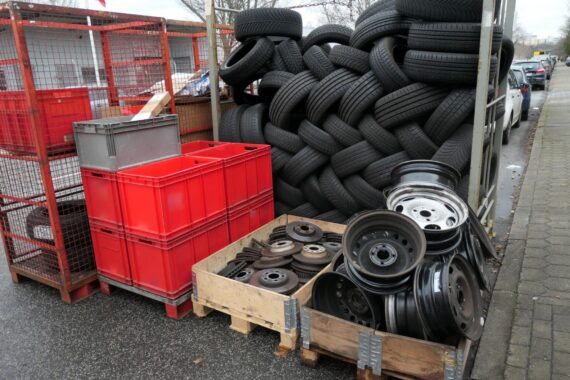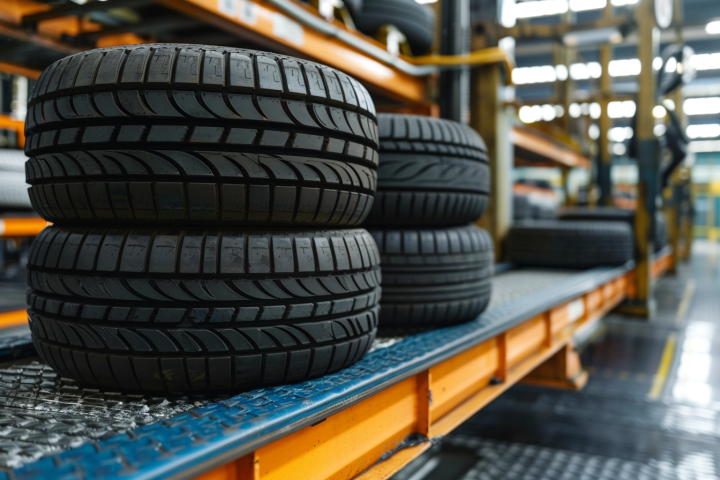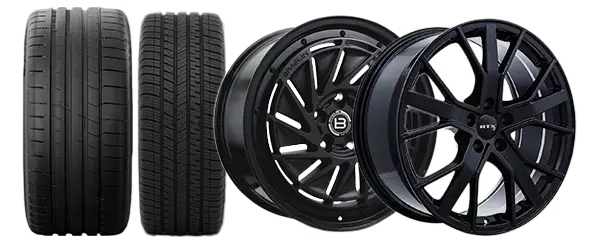Last Updated on 4 months
Hidden Aspects of Tire and Wheel Purchases
Welcome to the comprehensive guide provided by Giga Tires, where we explore the crucial topic of selecting the right tires and wheels for your vehicle. When purchasing tires and wheels for your car, the decision involves much more than just picking a style or brand. In the guide “Hidden Costs: What to Know Before You Buy Tires and Wheels,” we delve into the often-overlooked aspects of buying tires and wheels that can impact your wallet and driving experience.
This guide is designed to provide in-depth insights and advice, helping you navigate the complexities of tire and wheel selection. We aim to give you the knowledge and insights to make informed, cost-effective decisions, ensuring your vehicle has the best possible tires and wheels for your needs and lifestyle.
The Significance of Selecting Proper Tires and Wheels
The choice of tires and wheels is far more significant than it might initially appear. This decision impacts not just the aesthetic appeal of your vehicle but, more importantly, its performance, safety, and overall cost-effectiveness. Here is why making the right choice is crucial:
- Safety: Your tires are the only part of your vehicle that makes contact with the road. The right tires can significantly improve handling, reduce braking distances, and enhance traction in various weather conditions. Choosing inappropriate tires can compromise your vehicle’s stability and safety.
- Performance: Tires and wheels are pivotal in your vehicle’s handling characteristics. The right combination can enhance steering response, improve fuel efficiency, and provide a smoother ride. Conversely, the right choice can lead to better handling, increased fuel consumption, and a more comfortable driving experience.
- Cost Implications: While the initial cost is an obvious factor, hidden costs are associated with tires and wheels, such as longevity, maintenance, and impact on fuel efficiency. Investing in the correct set of tires and wheels can save you money in the long run through extended tire life and improved fuel economy.
- Environmental Impact: Selecting durable and fuel-efficient tires reduces the carbon footprint. Moreover, considering recyclable tires made from sustainable materials can further lessen environmental impact.
Aim and Scope of This Comprehensive Guide
This guide provides a holistic view of the tire and wheel selection process. Our scope includes:
- Educating on Different Types of Tires and Wheels: Understanding the differences between various tire types (all-season, performance, off-road, etc.) and wheel materials (alloy, steel, etc.) is fundamental. This knowledge helps you choose the best fit for your vehicle and driving conditions.
- Analyzing Costs: We looked into the costs associated with purchasing tires and wheels, going beyond the price tag to consider factors like longevity, maintenance, and their impact on fuel efficiency.
- Performance and Safety Considerations: This guide highlights how the right tires and wheels influence your vehicle’s performance, handling, and safety, offering practical advice for different driving conditions and vehicle types.
- Maintenance and Longevity: We provide tire and wheel maintenance tips, helping you extend their lifespan and ensure consistent performance.
- Purchasing Strategies: We cover various strategies for making an informed purchase, from comparing brands and prices to understanding the benefits of buying online vs. in-store.
- Environmental Considerations: Highlighting the ecological aspects of tire and wheel choices, this guide encourages more sustainable and eco-friendly practices.
This guide is designed to be your go-to resource for tire and wheel selection. By understanding these critical components, you can make informed decisions that enhance your driving experience, ensure safety, and optimize your vehicle’s performance while being mindful of costs and environmental impact. Stay tuned as we delve deeper into these topics in the following sections.
Understanding Tire and Wheel Basics
Navigating the world of tires and wheels can be a complex task. This section, part of Giga Tires’ comprehensive guide, is dedicated to simplifying these complexities and helping you understand the basics of tires and wheels. We’ll explore the different types of tires, wheel specifications, and the importance of tire size and profile.
Types of Tires: Which is Right for Your Vehicle?
Choosing the correct type of tire for your vehicle is crucial for ensuring optimal performance and safety. Here are the most common types of tires:
- All-Season Tires: These tires are designed to perform well in various conditions, including wet roads and light winter driving. They offer a good balance between performance and longevity.
- Summer Tires: Best suited for high temperatures and dry conditions, summer tires offer improved performance, agility, and braking efficiency in warm weather.
- Winter Tires: Specifically designed for cold weather and snow-covered roads, winter tires have a unique tread design and rubber compound for better grip and handling in snowy and icy conditions.
- Performance Tires: These are tailored for sports cars and performance vehicles, offering high-speed capabilities and superior handling for more aggressive driving.
- Off-Road Tires: Ideal for vehicles frequently driven on unpaved roads and rough terrain. They have deep tread patterns and robust construction to handle challenging off-road conditions.
Wheel Specifications and Compatibility
Often confused with rims, wheels are crucial to your vehicle’s performance. Understanding wheel specifications is critical to ensuring compatibility with your tires and vehicle. Consider these factors:
- Material: Wheels are typically made of steel or alloy. Steel wheels are more durable and cost-effective, while alloy wheels are lighter and offer better performance.
- Size: Wheel size impacts your vehicle’s handling and appearance. Larger wheels can enhance handling but may affect ride comfort.
- Bolt Pattern refers to the number of bolts and the circle diameter they form. Matching the wheel’s bolt pattern with your vehicle is essential for proper fitting.
- Offset is the distance between the wheel’s mounting surface and the centerline. The correct offset ensures the wheels fit within the wheel wells without rubbing against the suspension or body.
Importance of Tire Size and Profile
The size and profile of your tires are not just about aesthetics; they significantly impact your vehicle’s handling, fuel efficiency, and safety.
- Tire Size is usually indicated by a series of numbers and letters on the tire’s sidewall. It includes width, aspect ratio (profile), and diameter. The right size ensures your tires have the correct contact patch with the road.
- Profile: Low-profile tires (with a smaller aspect ratio) offer better handling and a sportier look but can compromise ride comfort and are more prone to damage from road imperfections.
Understanding the basics of tires and wheels is essential for any vehicle owner. By choosing the right type of tire, ensuring wheel compatibility, and selecting the appropriate tire size and profile, you can significantly enhance your vehicle’s performance, safety, and driving experience. Remember, the right combination of tires and wheels is not just about how they look; it’s about how they work together to keep you safe and enhance your driving experience.
Navigating Tire Sizes and Brands
Understanding Tire Size:
Learn how to decode the tire size labels on your tires, unraveling the essential information that guides your choice for replacements or upgrades.
- Size Matters: Check the sticker near the driver’s seat for your car’s tire size. Deviating more than 10mm in width can strain the suspension and affect fuel efficiency.
- Fit and Safety: A wider tire might not fit properly on the rim, posing safety risks. Sticking to the recommended size is better unless you’re up for a quality upgrade.
Decoding Tire Size Labels
How to decode the tire size labels on your tires, unraveling the essential information that guides your choice for replacements or upgrades.
- The Size Breakdown: Take “P215/65 R15” as an example. This means that the tire is 215mm wide, has a profile height of 65% of its width (139.75mm), and fits a rim with a 15-inch radial diameter.
- Practical Example: A standard Honda City uses 175/70 R15 tires. Switching brands with similar specs is fine, but drastic changes can affect the car’s balance.
Adjustments for Comfort and Safety
Explore how adjusting tire size can impact your driving experience, comfort, and safety, helping you make informed decisions when choosing the right fit for your vehicle.
- Minor Tweaks for a Smoother Ride: Sometimes, a slight adjustment in tire size can improve navigation over speed bumps and potholes, though it may slightly alter speedometer readings.
- Availability Issues: Need help finding your size? Look beyond your local shop, especially for less standard sizes.
Choosing the Right Tire Brand
Understand the significance of selecting the right tire brand, considering factors like quality, reliability, and performance to ensure a safe and satisfying driving experience.
- Brands Galore: Options include General Tires, Dunlop, Yokohama, Continental, and Michelin. Research each brand online for specifics.
- Quality and Cost: European and Japanese brands, like Yokohama, might be pricier but usually offer better durability and performance.
- Balancing Budget and Features: With many options in the 185/70 R15 range for a Honda City, choose cost or specific tire features based on your priorities.
Unveiling the Hidden Costs
Purchasing tires and wheels goes beyond the initial price tag in the automotive world. This segment is part of Giga Tires’ comprehensive guide on the often unseen costs associated with tire and wheel purchases. We’ll break down the various aspects of pricing, the balance between quality and price, and the hidden expenses you might have yet to consider.

Breaking Down the Price: More Than Just the Tag
Beyond the initial purchase price, several factors influence tire and wheel selection, including:
- Longevity and Durability: Lower-priced tires may offer initial savings, but their diminished tread life can necessitate earlier replacements, potentially negating cost advantages. Conversely, investing in higher-durability tires can prove more cost-effective, considering long-term value.
- Fuel Efficiency: Tires significantly affect your vehicle’s fuel consumption. Some tires are designed to reduce rolling resistance, thereby improving fuel efficiency. While these may come at a higher initial cost, the savings on fuel can be substantial over time.
- Seasonal Changes: When considering vehicle ownership in areas with variable weather, factor in the potential costs of seasonal tire changes.
Quality Versus Cost: Striking a Balance
Finding the right balance between quality and cost is crucial. Here is what to keep in mind:
- Safety: Never compromise on safety for cost. High-quality tires provide better traction, handling, and braking, which are crucial for your safety on the road.
- Brand and Warranty: Sometimes, paying extra for a reputable brand with a good warranty offers peace of mind and can be more economical in case of defects or issues.
- Performance Needs: Factor in driving habits and terrain. For frequent use or demanding conditions, prioritize higher-quality tires for enhanced performance and safety.
Hidden Expenses: Installation and Additional Equipment
Your checkout price isn’t the end of your tire and wheel expenses. Consider these often-overlooked costs:
- Installation and Balancing: The cost of mounting and balancing new tires and wheels is usually included in the purchase price.
- Tire Disposal Fees: When getting new tires, there is often a fee for properly disposing of your old ones.
- Additional Equipment: Depending on the type of vehicle and the type of tires you purchase, you might need other equipment, such as new rims or tire pressure monitoring system (TPMS) sensors, which can add to the overall cost.
- Maintenance: Regular tire rotations, alignments, and inspections are crucial for extending the life of your tires and ensuring your safety on the road. These maintenance costs can add up over time.
Understanding the full spectrum of costs associated with tires and wheels is crucial for making an informed purchase. This comprehensive approach ensures that you pay for tires and wheels and invest in your vehicle’s performance and safety on the road.
Factors Influencing Performance and Safety
In automotive care, selecting tires and wheels is not merely a matter of aesthetics but a critical decision impacting vehicle performance and safety. As part of the comprehensive guide from Giga Tires, this section delves into how tire and wheel choices influence driving dynamics, the significance of tread patterns, and the vital role of air pressure and tire health.
How Tire and Wheel Choice Affects Vehicle Handling
Selecting tires and wheels is crucial for both safety and vehicle performance. They impact handling, braking, fuel efficiency, and ride comfort. This guide empowers informed decisions for these essential automotive investments:
- Tire Size and Width: Larger tires may enhance stability and grip but also affect steering responsiveness. Wider tires provide a larger contact area with the road, offering better traction but potentially impacting fuel efficiency.
- Tire Compound: The tire’s material makeup influences grip, handling, and wear. Softer compounds provide better grip but wear out faster, while more complex compounds last longer but may not perform similarly.
- Wheel Weight: Heavier wheels can increase unsprung mass, affecting suspension response and ride comfort. Lighter wheels improve handling and acceleration.
The Role of Tread Patterns in Different Conditions
Tread patterns are not just a design feature – they play a pivotal role in how tires perform under various conditions:
- Wet Conditions: Tires with deep grooves and specialized patterns help channel water away from the tire, reducing the risk of hydroplaning and maintaining traction in moist conditions.
- Off-Road Traction: For vehicles that venture off the beaten path, tires with larger, more aggressive tread patterns provide the necessary grip and stability on rough terrains.
- Snow and Ice: Winter tires feature unique tread designs and siping (thin slits across the tire surface) to grip snow and ice, providing safer handling in extreme cold weather conditions.
Importance of Air Pressure and Tire Health
Maintaining the correct air pressure and regular tire health checks are essential for safety and performance:
- Air Pressure: Proper inflation is critical for optimal tire performance and longevity. Under-inflated tires can lead to increased wear and tear, reduced fuel efficiency, and even tire failure. Over-inflation can result in a harsher ride and uneven tire wear.
- Regular Inspections: Checking for wear patterns, punctures, and other damage helps identify issues early. This includes monitoring tread depth, which is crucial for maintaining grip and handling efficiency.
- Alignment and Rotation: Regular tire rotations and keeping your vehicle’s alignment in check ensure even tire wear, extending their lifespan and maintaining consistent performance.
A comprehensive understanding of how tires and wheels affect your vehicle’s handling, the role of tread patterns in various conditions, and the importance of tire health and air pressure is fundamental in ensuring optimal performance and safety.
Life Cycle and Sustainability
Understanding the life cycle and sustainability of tires and wheels is crucial in contemporary vehicle maintenance. This section of the Giga Tires guide focuses on the longevity of these essential components, their environmental impact, and the necessary upkeep for optimal lifespan. It is designed to give vehicle owners the knowledge to make environmentally responsible choices and ensure the longest possible use of their tires and wheels.
Longevity of Tires and Wheels: What to Expect
Various factors, including the type of tire, driving habits, and maintenance practices, influence the lifespan of tires and wheels.
- Average Lifespan: Tires are designed to last between 25,000 to 50,000 miles. However, high-performance tires may have a shorter lifespan due to softer rubber compounds used for better grip.
- Factors Affecting Longevity: Driving habits, road conditions, and climate significantly impact tire wear. Regular driving on rough roads, extreme temperatures, or aggressive driving styles can reduce a tire’s lifespan.
- Wheel Durability: Wheels generally have a longer lifespan than tires, but potholes, curb impacts, and corrosion can damage them. At the same time, lighter and offering better performance, alloy wheels may be more susceptible to damage than steel wheels.
Recycling and Environmental Considerations
The environmental impact of tires and wheels is a growing concern, but there are sustainable practices to consider.
- Tire Recycling: Tires are recyclable, and there are numerous ways to repurpose used tires, including in construction materials, playground surfaces, and energy recovery.
- Reducing Carbon Footprint: Eco-friendly tires are designed to reduce rolling resistance, improve fuel efficiency, and reduce carbon emissions.
- Manufacturing Practices: Some manufacturers are adopting more sustainable practices, including using eco-friendly materials and reducing waste in producing tires and wheels.
Upkeep and Care for Optimal Lifespan
Proper maintenance can significantly extend the life of your tires and wheels.
- Regular Inspections: Routine checks for tire pressure, tread depth, and overall tire condition are essential. Maintaining proper tire pressure extends tire life and ensures safety and fuel efficiency.
- Rotation and Alignment: Regular tire rotations and wheel alignments promote even wear, extending the life of your tires.
- Cleaning and Storage: Proper cleaning and storage of tires and wheels, especially when swapping seasonal tires, can prevent damage and corrosion.
Smart Purchasing Strategies
Purchasing tires and wheels is a significant decision that requires careful consideration in automotive maintenance. This section, part of the comprehensive guide provided by Giga Tires, focuses on intelligent purchasing strategies. It guides you through researching brands, weighing the pros and cons of online shopping, and understanding the intricacies of warranties and guarantees. These insights aim to empower you with the knowledge to make informed decisions when investing in tires and wheels.
Researching and Comparing Different Brands
The first step in purchasing tires and wheels is to conduct thorough research and compare different brands. Here’s how to go about it:
- Understand Your Needs: Before delving into brands, understand what you need based on your driving habits, vehicle type, and environmental conditions.
- Brand Reputation: Investigate the reputation of various tire and wheel brands. Look for customer reviews, ratings, and expert opinions to gauge reliability and performance.
- Price vs. Quality: Compare the prices of different brands and models and consider their quality and features. Remember, the cheapest option may only sometimes be the best in terms of performance and longevity.
- Special Features: Some brands offer tires and wheels with unique features, such as run-flat technology or tires specifically designed for electric vehicles. Consider whether these features are beneficial for your needs.
The Pros and Cons of Online Shopping for Tires and Wheels

Online shopping for tires and wheels has become increasingly popular. Here are its advantages and disadvantages:
Pros:
- Convenience: Shopping online is convenient. It is possible to browse a wide range of products from the comfort of your home.
- Variety: Online retailers often have a broader selection of brands and models than physical stores.
- Price Comparison: It is easier to compare prices and find the best deals online.
Cons:
- Lack of Physical Inspection: It is impossible to physically inspect the product before purchasing.
- Shipping Costs: Some online purchases may include additional shipping costs.
- Installation: Buying online means finding a separate installation service is necessary.
Navigating Warranties and Guarantees
Understanding warranties and guarantees is crucial in making a smart purchase:
- Types of Warranties: Familiarize yourself with the types of warranties offered, such as manufacturer’s warranty, tread life warranty, and road hazard warranty.
- Read the Fine Print: Carefully read the warranty terms. Pay attention to what is covered, for how long, and any conditions or limitations.
- Guarantees and Return Policies: Check the retailer’s return policy. Some offer satisfaction guarantees, allowing you to return the product within a specified period if it does not meet your expectations.
- Extended Warranties: Consider whether purchasing an extended warranty benefits your needs and budget.
Employing innovative purchasing strategies when buying tires and wheels involves extensive research, understanding the advantages and limitations of online shopping, and navigating the complexities of warranties and guarantees.
Conclusion & Recommendations
As we wrap up this comprehensive guide, it’s essential to consolidate the insights we’ve gathered and provide final advice to assist you in making an informed decision about your tire and wheel purchases.
Throughout this guide, we have explored various facets of tire and wheel selection, emphasizing their significance in vehicle performance, safety, and cost-effectiveness. We delved into the types of tires and wheels, highlighting the importance of choosing the right kind based on your driving needs and conditions. We unveiled the hidden costs associated with these purchases, stressing the need to look beyond the initial price tag and consider long-term expenses like maintenance, fuel efficiency, and environmental impact.
We also examined the role of tire and wheel choices in vehicle handling, the importance of tread patterns in different driving conditions, and the criticality of maintaining proper air pressure and tire health. Moreover, the guide highlighted the need for sustainable tire usage and disposal practices, underscoring the significance of recycling and environmental considerations.
Making an Informed Decision: Final Advice
Making a well-informed decision when purchasing tires and wheels is critical. This involves thorough research, understanding your needs, and balancing quality with cost. Knowing your choices’ maintenance requirements and environmental impact is crucial. Remember, the right tire and wheel combination enhances your vehicle’s performance and ensures your safety on the road.
Consider Giga Tires your trusted partner as you embark on this necessary purchase. At Giga Tires, we offer an extensive selection of high-quality tires and wheels that cater to various needs and preferences. Our user-friendly website simplifies finding the right product for your vehicle, backed by detailed product descriptions and customer reviews to aid your decision-making.
Why Giga Tires
After equipping yourself with all this knowledge, the next step is to make your purchase. Giga Tires stands ready to assist you in selecting the perfect tires and wheels for your vehicle. With our comprehensive range, competitive pricing, and commitment to customer satisfaction, we are poised to meet all your tire and wheel needs.
Explore Your Options at Giga Tires
Whether you’re looking for performance, durability, or eco-friendly options, you’ll find what you need in our extensive catalog. Click the link to browse our selection and take the first step towards enhancing your vehicle’s performance and safety. Trust Giga Tires for your next tire and wheel purchase – where quality meets affordability and customer service excellence.
FAQs
What factors should be considered when purchasing tires?
When buying tires, consider the type (all-season, winter, performance), size, load capacity, speed rating, and compatibility with your vehicle—also, factor in your driving habits, local climate, and the usual road conditions you encounter.
How much should a set of wheels and tires cost?
The cost varies based on type, brand, and quality. On average, a basic set can range from $400 to $1,000, while high-performance or specialty tires can exceed $2,000. Remember, higher prices often reflect better quality and durability.
What questions to ask when buying tires?
Ask about the tire’s lifespan, suitability for your climate, vehicle compatibility, warranty coverage, performance in different road conditions, and additional costs, such as installation or disposal fees.
What qualities do you look for when shopping for new tires?
Look for good traction, durability, fuel efficiency, performance in weather conditions, low noise levels, and comfortable rides.
What does the price of the tire include?
The price typically covers the tire itself. However, the initial price might not include additional costs like installation, balancing, warranty, and disposal fees.
What do the tire sizes mean?
Tire sizes combine width, aspect ratio (profile), and rim diameter. For example, a size like 205/55R16 means the tire is 205mm wide, the height of the tire’s sidewall is 55% of its width, and it fits a 16-inch rim.
How much should I pay for tires?
The cost depends on your vehicle and needs. Budget tires can start from as low as $50 per tire, but for most vehicles, expect to pay between $100 to $300 for a balance of quality and performance.
What do I do when I need new tires?
Assess your vehicle’s requirements and driving conditions. Research various brands and types, compare prices, and consult a tire professional. Remember to consider both upfront costs and long-term value.
What is the major tire-wearing factor?
The most significant factor in tire wear is driving habits. Aggressive driving, frequent sharp braking, and high-speed cornering accelerate wear. Other factors include improper tire inflation, misalignment, and unbalanced tires.
What is the importance of having good tires?
Good tires are crucial for safety, as they are the only contact point between your vehicle and the road. They affect handling, braking, and traction, especially in adverse weather conditions.
Why is tire quality important?
High-quality tires ensure better road safety through improved grip, stability, and braking efficiency. They also contribute to better fuel efficiency and a comfortable ride, and can be more cost-effective in the long run due to longer wear life.










